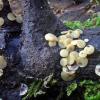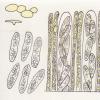
28-10-2025 19:33
 Nicolas Suberbielle
Nicolas Suberbielle
Bonjour à tous,Je voudrais votre avis sur cette r

31-10-2025 09:19
 Lothar Krieglsteiner
Lothar Krieglsteiner
Can somebody provide me with a file of:Rogerson CT

09-08-2025 13:13
 Maria Plekkenpol
Maria Plekkenpol
Hello,Yesterday I found these on burnt soil. Apoth

25-11-2016 13:54
 Stephen Martin Mifsud
Stephen Martin Mifsud
Hi, I found numerous seeds of Washingtonia robusta

28-10-2025 22:22
 Bernard Declercq
Bernard Declercq
Hello.I'm searching for the following paper:Punith

28-10-2025 15:37
Carl FarmerI'd be grateful for any suggestions for this strik
Hymenoscyphus de Bouverans
Gilbert MOYNE,
03-10-2013 19:05
Sur branche morte de feuillu (peut-être saule) en bordure d'une bauge à sanglier, Bouverans (Doubs), Montagne du Laveron, 800 m, 02/10/2013.
Apothécies 3-5 mm de diamètre, courtement stipitées, grégaires. Hyménium jaune d'or pâle, jaune paille. Stipe de moins de 1 mm, un peu brun à la base.
Asques cylindriqyues à claviformes, avec crochets, J+, 130-140 x 9-10 µm
Paraphyses cylindriques, non élargies au sommet (3-4 µm), peu septées, farcies de gouttelettes jaunes.
Spores elliptiques à scutuloïdes, parfois légèrement comprimées au centre, contenant de nombreuses gouttelettes, 15-19 x 4,5-6 µm
J'arrive du côté de H. epiphyllus ou H. laetus mais sans aucune certitude.
Merci de votre aide
Gilbert
Hans-Otto Baral,
03-10-2013 19:44

Re : Hymenoscyphus de Bouverans
Cher Gilbert
I am convinced that this is Hymenosc. subferrugineus. Quite a common species especially in the region around the Alps, but it occurs also in England and Scandinavia, from where it was originally described by Phillips (on bark, as Hymenoscypha broomei) and Nylander (on branch of Ribes alpinum).
The spores are slightly scutuloid, with an asymmetry at the apex, so that it is possible to say which is the upper and lower end. This is not possible in H. epiphyllus and H. laetus.
Zotto
I am convinced that this is Hymenosc. subferrugineus. Quite a common species especially in the region around the Alps, but it occurs also in England and Scandinavia, from where it was originally described by Phillips (on bark, as Hymenoscypha broomei) and Nylander (on branch of Ribes alpinum).
The spores are slightly scutuloid, with an asymmetry at the apex, so that it is possible to say which is the upper and lower end. This is not possible in H. epiphyllus and H. laetus.
Zotto
Gilbert MOYNE,
03-10-2013 20:48
Re : Hymenoscyphus de Bouverans
Bonsoir Zotto,
Un grand merci pour la détermination et pour les explications.
Gilbert
Un grand merci pour la détermination et pour les explications.
Gilbert
Michel Hairaud,
03-10-2013 21:06

Re : Hymenoscyphus de Bouverans
Bonsoir Gilbert et Zotto,
Ton intérêt pour les Helotiales maintenant fait plaisir à voir, Gilbert !
Je n'ai pas l'habitude de cette espèce à l'ouest de la France , alors que epiphyllus y est très commun . Peut être devrais je reprendre l'étude de certaines récoltes non abouties... Do you know, Zotto, whether the finds in England and Northern Europe wera collected in mountainous areas ?
Amitiés
Michel
Ton intérêt pour les Helotiales maintenant fait plaisir à voir, Gilbert !
Je n'ai pas l'habitude de cette espèce à l'ouest de la France , alors que epiphyllus y est très commun . Peut être devrais je reprendre l'étude de certaines récoltes non abouties... Do you know, Zotto, whether the finds in England and Northern Europe wera collected in mountainous areas ?
Amitiés
Michel
Hans-Otto Baral,
03-10-2013 21:30

Re : Hymenoscyphus de Bouverans
Hi Michel
I am likewise pleased about Gilbert's passion :-)
To your question: Ribes alpinum sounds so, and H. broomei was collected in Somersetshire (unlocalized). Ah, there is a further synonym: Helotium sublateritium Berk. & Broome from Scotland, Angus, Glamis. you know these old Guys were usually rather unprecise with their localities.
I frequently collected this species in the Calcarean Alps, but it occurs also in lowlands, for instance near Tübingen, Heidelberg or Chemnitz (all in colline altitude). Also in Asturias at Picos de Europa or Huesca, Pyrenees.
Forgot to add that H. calyculus is not easily separable. I still believe the two are different. interestingly, we have several sequences of H. subferrugineus and they are all practically identical. Also some of H. calyculus exist but these are rather different from each other and should concern different species, but all are quite distant from subferrugineus.
Zotto
I am likewise pleased about Gilbert's passion :-)
To your question: Ribes alpinum sounds so, and H. broomei was collected in Somersetshire (unlocalized). Ah, there is a further synonym: Helotium sublateritium Berk. & Broome from Scotland, Angus, Glamis. you know these old Guys were usually rather unprecise with their localities.
I frequently collected this species in the Calcarean Alps, but it occurs also in lowlands, for instance near Tübingen, Heidelberg or Chemnitz (all in colline altitude). Also in Asturias at Picos de Europa or Huesca, Pyrenees.
Forgot to add that H. calyculus is not easily separable. I still believe the two are different. interestingly, we have several sequences of H. subferrugineus and they are all practically identical. Also some of H. calyculus exist but these are rather different from each other and should concern different species, but all are quite distant from subferrugineus.
Zotto
Marcel Vega,
03-10-2013 23:00
Re : Hymenoscyphus de Bouverans
Hi Zotto and Michel,
I will pay a visit to Gilbert soon and take care that he won't plunge into such odd stuff like Hymenoscyphus all too much!
You're welcome!
Marcel
I will pay a visit to Gilbert soon and take care that he won't plunge into such odd stuff like Hymenoscyphus all too much!
You're welcome!
Marcel
Michel Hairaud,
03-10-2013 23:26

Re : Hymenoscyphus de Bouverans
Thanks Zotto,
H. calyculus and subferrugineus seem very close indeed.
(Marcel, I feel sure you will also appreciate inoperculates once you will have tasted Helotiales :-)
Michel
H. calyculus and subferrugineus seem very close indeed.
(Marcel, I feel sure you will also appreciate inoperculates once you will have tasted Helotiales :-)
Michel
Marcel Vega,
03-10-2013 23:43
Re : Hymenoscyphus de Bouverans
Already tried this wine:tasted like vinegar, dear Michel.
But who knows maybe a pastime for life after death?
M.
But who knows maybe a pastime for life after death?
M.




